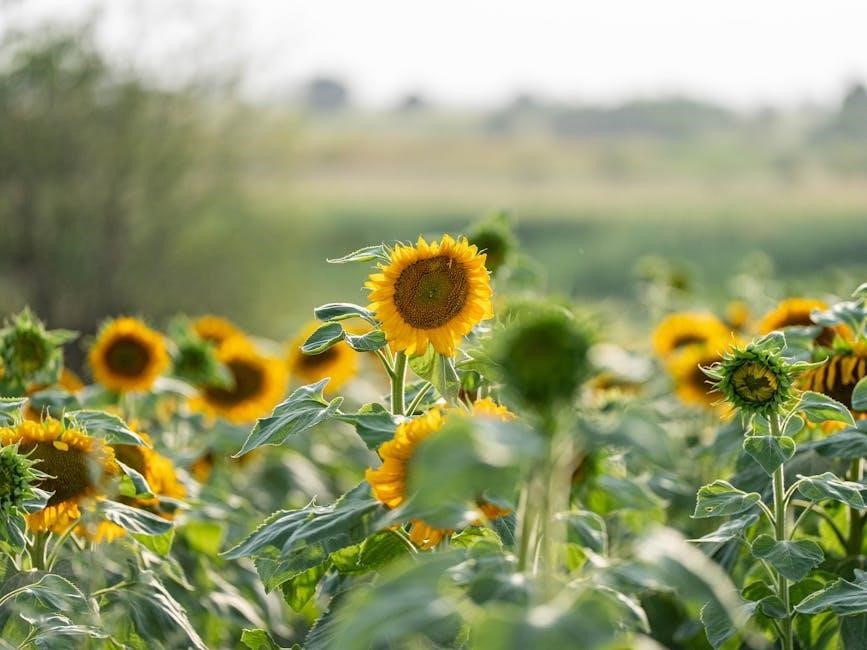Photosynthesis is a vital process where plants, algae, and some bacteria convert sunlight, carbon dioxide, and water into glucose and oxygen, sustaining life on Earth.
1.1 Overview of Photosynthesis
Photosynthesis is a biological process where plants, algae, and some bacteria convert sunlight, carbon dioxide, and water into glucose and oxygen. This essential process occurs in chloroplasts and involves two main stages: light-dependent reactions and light-independent reactions. Light-dependent reactions capture energy from sunlight, while light-independent reactions use this energy to produce glucose. Photosynthesis is crucial for providing oxygen and organic compounds to ecosystems, supporting life on Earth. Worksheets on photosynthesis often include diagrams, equations, and activities to help students understand this process, emphasizing its role in energy conversion and the interconnectedness of living organisms. These resources are widely available in PDF formats for educational purposes.
1.2 Importance of Photosynthesis in Ecosystems
Photosynthesis is the foundation of life on Earth, providing oxygen and organic compounds essential for survival. It sustains food chains by producing glucose, which powers herbivores and, indirectly, carnivores. This process maintains carbon balance by converting carbon dioxide into organic molecules, mitigating climate change. Worksheets often highlight its role in ecosystems, emphasizing how it supports aquatic and terrestrial life. Without photosynthesis, life as we know it would cease, making it a cornerstone of biodiversity and ecological stability. Understanding its importance through educational resources, like PDF worksheets, helps students appreciate its global impact on energy flow and carbon cycling.
1.3 Materials Needed for the Worksheet
To complete a photosynthesis worksheet, students typically need a printed or digital PDF copy of the worksheet, a pen or pencil for writing answers, and a computer or tablet for accessing online resources. Colored pencils may be required for labeling diagrams or illustrating processes. Access to the internet is often necessary for interactive activities, such as online quizzes or animations. A PDF viewer or compatible software is essential for opening and viewing the worksheet. Additionally, teachers may provide supplementary materials like scissors or glue for hands-on activities. Ensuring all materials are readily available enhances the learning experience and allows students to engage fully with the content.

The Photosynthesis Process
Photosynthesis involves converting sunlight, carbon dioxide, and water into glucose and oxygen, occurring in plant chloroplasts. It sustains life by producing energy-rich molecules essential for growth.

2.1 Light-Dependent Reactions
The light-dependent reactions occur in the thylakoid membranes of chloroplasts. Chlorophyll and other pigments absorb sunlight, initiating the conversion of light energy into chemical energy. Water molecules are split, releasing oxygen as a byproduct. This process generates ATP and NADPH, which are essential for the Calvin Cycle. The reactions rely on light intensity and pigment efficiency, making them a critical first step in photosynthesis. These reactions ensure energy is stored in usable forms, enabling the subsequent production of glucose. Understanding this stage is vital for grasping how photosynthesis powers life on Earth. Worksheet activities often include diagrams and questions to help students master this concept.
2.2 Light-Independent Reactions (Calvin Cycle)
The Calvin Cycle, or light-independent reactions, occurs in the stroma of chloroplasts. It uses ATP and NADPH produced in the light-dependent reactions to fix carbon dioxide into glucose. The cycle involves CO2 fixation, reduction, and regeneration of RuBP. Enzymes play a crucial role, especially RuBisCO, which catalyzes CO2 fixation. The cycle is essential for producing organic molecules, supporting life. Worksheets often include diagrams and questions to help students understand this process. The Calvin Cycle ensures plants can synthesize the energy they need, making it a cornerstone of photosynthesis. It operates in the absence of light, relying on stored energy from the light-dependent reactions.
2.3 Stages of Photosynthesis
Photosynthesis occurs in two main stages: the light-dependent reactions and the light-independent reactions (Calvin Cycle). The light-dependent stage takes place in the thylakoid membranes of chloroplasts, where sunlight is absorbed by pigments like chlorophyll. This stage involves the splitting of water molecules, releasing oxygen, and producing ATP and NADPH. The light-independent stage occurs in the stroma, where CO2 is fixed into glucose using the ATP and NADPH from the first stage. These stages work together to convert light energy into chemical energy stored in glucose. Worksheets often include diagrams and questions to help students understand these processes and their interdependence, making them essential for learning about energy conversion in plants.

Key Components of Photosynthesis
Chloroplasts, chlorophyll, water, carbon dioxide, and sunlight are the key components of photosynthesis. Chloroplasts contain chlorophyll, which captures light energy to fuel the process.
3.1 Chloroplasts and Their Role
Chloroplasts are organelles found in plant cells where photosynthesis occurs. They contain pigments like chlorophyll, which absorbs sunlight, and enzymes that facilitate glucose production. Chloroplasts have a membrane enclosing a fluid-filled stroma and thylakoids stacked into grana. The thylakoids are the site of light-dependent reactions, while the stroma hosts the Calvin Cycle. This organelle is essential for converting light energy into chemical energy, producing oxygen as a byproduct. Without chloroplasts, plants couldn’t synthesize food, making them vital for life on Earth. Chloroplasts are a key focus in photosynthesis worksheets, highlighting their structure and function in educational materials.
3.2 Chlorophyll and Other Pigments
Chlorophyll is the primary pigment in chloroplasts, enabling plants to absorb sunlight for photosynthesis. It absorbs blue and red light but reflects green, giving plants their color. Chlorophyll a and b are the main types, with chlorophyll a being the most critical for energy transfer. Other pigments like carotenoids (e.g., carotene and xanthophylls) absorb different wavelengths, complementing chlorophyll. These pigments protect plants from excessive light and assist in energy transfer. Chlorophyll molecules have a porphyrin ring and a long hydrocarbon tail, allowing them to embed in thylakoid membranes. Their role in capturing light energy is vital for the light-dependent reactions. Chlorophyll degradation in autumn reveals hidden pigments, creating colorful foliage.
3.3 Raw Materials: Water, Carbon Dioxide, and Sunlight
Photosynthesis requires three essential raw materials: water, carbon dioxide, and sunlight. Water is absorbed by plant roots and transported to chloroplasts, where it is split during light-dependent reactions. Carbon dioxide enters plants through stomata, small pores on leaves, and is used in the Calvin Cycle to produce glucose. Sunlight provides the energy needed to drive these reactions, with chlorophyll absorbing specific wavelengths to initiate electron transfer. These materials are critical for converting light energy into chemical energy, forming glucose and releasing oxygen as a byproduct. Without any of these components, photosynthesis cannot occur, making them fundamental for plant survival and ecosystem balance.
Outputs of Photosynthesis
Photosynthesis produces glucose and oxygen as its primary outputs. Glucose is used by plants for energy and growth, while oxygen is released into the atmosphere.
4.1 Glucose Production
Glucose is the primary energy-rich product synthesized during photosynthesis. It is produced in the Calvin cycle, where carbon dioxide is fixed and reduced using ATP and NADPH generated from the light-dependent reactions. This process occurs in the stroma of chloroplasts and results in the formation of a six-carbon sugar, which is then split into two molecules of glucose. Glucose serves as a vital energy source for plants, supporting growth and development. Additionally, it is stored for later use, often in the form of starch. Glucose also plays a critical role in the food chain, serving as a foundational energy source for herbivores and, indirectly, for other organisms.
4.2 Oxygen Release
Oxygen is a byproduct of photosynthesis, primarily released during the light-dependent reactions. It is produced when water molecules are split in the thylakoid membranes of chloroplasts, releasing oxygen as a gas. This process occurs in plants, algae, and certain bacteria, making oxygen available in the atmosphere. The release of oxygen is essential for aerobic respiration in most living organisms, including plants themselves. Without this process, life as we know it would not exist. The oxygen released during photosynthesis supports the Earth’s ecosystems, making it a critical component of the global oxygen cycle. This process underscores the vital role of photosynthesis in sustaining life on Earth.
4.3 Energy Storage in Glucose
Glucose, a simple sugar, is the primary energy storage molecule produced during photosynthesis. It is synthesized in the Calvin Cycle, where carbon dioxide is fixed into organic molecules. Plants use glucose to fuel metabolic processes, such as growth and development. Excess glucose is stored as starch or cellulose in plant cells, serving as a reserve for future energy needs. This energy-rich molecule is also vital for heterotrophic organisms, including humans and animals, as it is a key energy source in the food chain. The energy stored in glucose is released through cellular respiration, making it a critical link between photosynthesis and the survival of nearly all living organisms on Earth.

Worksheet Activities
Engage with reading comprehension, crossword puzzles, and multiple-choice questions to reinforce photosynthesis concepts. These activities promote interactive learning and comprehension of the photosynthesis process.
5.1 Reading Comprehension Exercises
Reading comprehension exercises are designed to enhance understanding of photosynthesis through structured passages and questions. Students analyze texts about how plants produce glucose and oxygen, exploring the roles of sunlight, water, and carbon dioxide. These exercises often include multiple-choice questions, true/false statements, and short-answer prompts to assess comprehension. For example, passages might describe the light-dependent and light-independent reactions, prompting students to identify key processes. Some worksheets include stories or scenarios, such as “How Plants Make Food,” followed by questions to test understanding. These activities encourage critical thinking and reinforce the fundamental concepts of photosynthesis in an engaging and interactive manner.
5.2 Crossword Puzzles and Word Searches
Crossword puzzles and word searches are engaging tools to reinforce vocabulary related to photosynthesis. These activities often include terms like “chlorophyll,” “chloroplasts,” and “Calvin cycle.” Students match definitions or clues to fill in the puzzles, enhancing their retention of key concepts. Word searches might hide words such as “glucose,” “oxygen,” and “carbon dioxide,” encouraging active learning. These exercises are frequently included in PDF worksheets, making them easy to print and distribute. They provide a fun alternative to traditional study methods, helping students build confidence in their understanding of photosynthesis while developing problem-solving skills in an interactive and enjoyable way. This approach caters to different learning styles, ensuring comprehension and engagement.
5.3 Multiple-Choice Questions
Multiple-choice questions are an effective way to assess students’ understanding of photosynthesis. These questions typically cover key concepts such as the role of chlorophyll, the stages of photosynthesis, and the importance of light intensity. Students are presented with a question and several possible answers, requiring them to select the correct one. This format helps identify knowledge gaps and reinforces learning. Worksheets often include a variety of MCQs to ensure comprehensive coverage of the topic. Answers are usually provided separately, allowing for self-assessment. This method is popular in PDF worksheets due to its clarity and ease of use, making it a valuable tool for both teachers and students to track progress and understanding effectively.
5.4 Short Answer Questions
Short answer questions require students to provide concise yet detailed responses, fostering deeper understanding and critical thinking. These questions often ask students to explain processes, such as how chlorophyll captures light energy or the role of the Calvin Cycle. They may also inquire about the importance of factors like carbon dioxide concentration or light intensity. Students must articulate their knowledge clearly, using complete sentences and avoiding bullet points or outlines. This format helps teachers evaluate the depth of understanding and identify areas where further instruction is needed. Worksheets with short answer sections encourage students to organize their thoughts and communicate scientific concepts effectively, making them a valuable educational tool for reinforcing learning objectives in a structured manner. Additionally, these questions prepare students for more advanced assessments by honing their ability to express complex ideas succinctly.

Experiments and Investigations
Experiments and investigations enable students to explore photosynthesis hands-on, measuring rates, testing light intensity, and observing the role of carbon dioxide in plant growth and energy production.
6.1 Measuring the Rate of Photosynthesis
Measuring the rate of photosynthesis involves tracking oxygen production or carbon dioxide uptake. One method uses aquatic plants, measuring bubble release to assess oxygen production rates. Another approach involves using sensors to monitor CO₂ levels in controlled environments. These experiments help students understand how variables like light intensity and CO₂ concentration affect photosynthesis efficiency. By analyzing data, students can observe the direct relationship between environmental factors and photosynthetic activity, reinforcing theoretical concepts through practical observation. Such investigations are essential for developing a deeper understanding of photosynthesis and its importance in ecosystems.
6.2 Effect of Light Intensity on Photosynthesis
Light intensity significantly influences the rate of photosynthesis; Experiments often involve placing plants under varying light conditions to measure oxygen production or carbon dioxide absorption. For instance, a water plant in a sealed container with a light source can be used to observe bubble formation, indicating oxygen release. Students hypothesize how different light intensities affect photosynthesis rates. Results typically show increased photosynthesis with higher light intensity, up to a point, after which factors like temperature or CO₂ availability become limiting. This activity helps students understand how environmental factors optimize photosynthesis, linking theoretical concepts to practical observations and real-world applications in agriculture and ecology.

6.3 Role of Carbon Dioxide in Photosynthesis
Carbon dioxide is a critical reactant in photosynthesis, essential for the Calvin Cycle, where it is fixed into organic molecules. Experiments often investigate how varying CO₂ concentrations affect photosynthesis rates. For example, a water plant placed in a sealed container with controlled CO₂ levels can demonstrate changes in oxygen production or leaf disk flotation. Results typically show increased photosynthesis with higher CO₂ levels, up to a saturation point. This activity helps students grasp the importance of CO₂ in the carbon cycle and its role in glucose production. It also highlights how environmental factors like CO₂ availability influence plant growth and productivity.
Interactive Learning Tools
Engaging animations, educational videos, quizzes, and games enhance learning by visualizing processes and testing knowledge, making complex concepts like photosynthesis accessible and fun for students.
7.1 Photosynthesis Animations and Videos
Photosynthesis animations and videos provide dynamic visualizations of the process, breaking down complex steps into engaging sequences. These resources often cover light-dependent and light-independent reactions, showing how chloroplasts, chlorophyll, and pigments function. Many animations include interactive elements, such as clickable diagrams or voiceover explanations, to enhance understanding. Videos are widely available on platforms like YouTube and educational websites, offering a range of styles to suit different learning preferences. Some resources are specifically designed to accompany worksheets, reinforcing concepts through both visual and hands-on activities. These tools are particularly effective for visual learners, helping them grasp the spatial and temporal aspects of photosynthesis. They also make abstract processes more tangible and memorable for students of all ages.
7.2 Online Quizzes and Games
Online quizzes and games are interactive tools that make learning about photosynthesis engaging and fun. These resources often include multiple-choice questions, crossword puzzles, and word searches tailored to photosynthesis topics. Games like matching activities or timed quizzes help students test their knowledge of light-dependent and light-independent reactions, chloroplasts, and chlorophyll. Many platforms offer instant feedback, allowing learners to track their progress and identify areas for improvement. These tools are designed to complement worksheets, providing a dynamic way to reinforce concepts. They cater to different learning styles, making photosynthesis education accessible and enjoyable for students of various ages and skill levels. Interactive learning enhances retention and motivation, fostering a deeper understanding of the subject.
7.3 Printable Worksheets and PDF Resources
Printable worksheets and PDF resources are essential tools for teaching and learning photosynthesis. These materials are designed to reinforce concepts through structured activities such as reading comprehension exercises, crossword puzzles, and short answer questions. PDFs often include detailed instructions and answers, making them ideal for self-study or classroom use. Many worksheets focus on specific aspects of photosynthesis, like the role of chlorophyll or the Calvin Cycle, providing a comprehensive understanding. Additionally, PDF resources frequently incorporate visual aids like diagrams and flowcharts to illustrate complex processes. These materials are widely available online, offering educators and students a convenient way to explore and master the subject of photosynthesis effectively and efficiently. They are adaptable to various learning environments and cater to different educational needs, ensuring a thorough grasp of the topic.

Assessment and Evaluation
Assessment and evaluation tools, such as quizzes and tests, help measure students’ understanding of photosynthesis concepts through multiple-choice questions and short answer responses.
8.1 Grading Criteria for Worksheets
Worksheets are graded based on accuracy, completeness, and understanding. Points are awarded for correct answers in multiple-choice and short-answer questions, with deductions for errors. Students must demonstrate clear comprehension of photosynthesis processes, including light-dependent and light-independent reactions. Proper use of scientific terminology and adherence to formatting instructions are also evaluated. Feedback is provided to highlight strengths and areas for improvement, ensuring students grasp key concepts like glucose production and oxygen release. Grading criteria are transparent, enabling students to track their progress effectively throughout the course.

8.2 Feedback and Improvement
Feedback is provided to students to enhance their understanding and performance in photosynthesis-related tasks. Constructive comments highlight strengths and areas needing improvement, ensuring clarity and precision in responses. Specific examples from worksheets are used to illustrate common misconceptions, such as confusion between light-dependent and light-independent reactions. Students are encouraged to review feedback and revise their work, fostering a deeper grasp of concepts like glucose production and oxygen release. Tips for improvement, such as additional reading or interactive tools, are often included to guide further learning. This iterative process helps students refine their knowledge and apply it effectively in future assessments.
8.3 Tracking Student Progress
Tracking student progress involves monitoring their performance and understanding throughout the photosynthesis worksheet activities. Teachers can use completed worksheets, quiz scores, and assignment submissions to assess learning outcomes. Progress is measured by improvements in accuracy, comprehension, and critical thinking skills. Student portfolios or digital dashboards can store completed tasks, allowing for a visual representation of growth over time. Regular check-ins and feedback sessions help identify areas where students may need additional support. By analyzing trends in performance, educators can tailor instruction to address common challenges, ensuring students grasp key concepts like glucose production and oxygen release. This systematic approach fosters continuous improvement and academic success.
9.1 Summary of Key Concepts

Photosynthesis is a critical biological process where plants, algae, and certain bacteria convert sunlight, carbon dioxide, and water into glucose and oxygen. This process occurs in chloroplasts, where chlorophyll plays a central role in absorbing light energy. The light-dependent reactions capture energy from sunlight, while the Calvin Cycle (light-independent reactions) fixes carbon dioxide into glucose. The worksheet highlights the importance of photosynthesis in producing oxygen and organic molecules essential for life. It also emphasizes the role of chloroplasts, pigments, and raw materials in sustaining this process. By understanding photosynthesis, students gain insights into how energy flows through ecosystems and supports food chains.
9.2 Real-World Applications of Photosynthesis
Photosynthesis is fundamental to agriculture, providing the oxygen we breathe and the food we consume. It supports plant growth, ensuring crop productivity and food security. Understanding photosynthesis aids in developing sustainable farming practices and improving yields. Additionally, it plays a role in combating climate change by absorbing carbon dioxide. Photosynthesis-inspired technologies, such as artificial photosynthesis, aim to create clean energy solutions; Educational tools like worksheets help students grasp these concepts, fostering awareness of environmental sustainability and the importance of preserving natural processes. By studying photosynthesis, we can better manage ecosystems and develop innovative solutions for global challenges, ensuring a greener and more sustainable future for generations to come.
9.3 Encouraging Further Learning
Encouraging further learning about photosynthesis involves exploring interactive resources and hands-on activities. Utilize worksheets, animations, and videos to visualize the process. Engage students with quizzes, crossword puzzles, and word searches to reinforce concepts. Conduct experiments, such as measuring the rate of photosynthesis or testing the effect of light intensity, to provide practical insights. Encourage students to research real-world applications, like artificial photosynthesis and its role in clean energy. Foster curiosity by discussing how photosynthesis impacts daily life, from food production to environmental balance. Provide access to printable PDF resources and online tools for self-paced learning. By making learning interactive and relevant, students will be inspired to explore photosynthesis and its significance in-depth.
